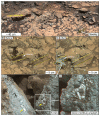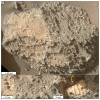Extraformational sediment recycling on Mars
- PMID: 33304202
- PMCID: PMC7116455
- DOI: 10.1130/GES02244.1
Extraformational sediment recycling on Mars
Abstract
Extraformational sediment recycling (old sedimentary rock to new sedimentary rock) is a fundamental aspect of Earth's geological record; tectonism exposes sedimentary rock, whereupon it is weathered and eroded to form new sediment that later becomes lithified. On Mars, tectonism has been minor, but two decades of orbiter instrument-based studies show that some sedimentary rocks previously buried to depths of kilometers have been exposed, by erosion, at the surface. Four locations in Gale crater, explored using the National Aeronautics and Space Administration's Curiosity rover, exhibit sedimentary lithoclasts in sedimentary rock: At Marias Pass, they are mudstone fragments in sandstone derived from strata below an erosional unconformity; at Bimbe, they are pebble-sized sandstone and, possibly, laminated, intraclast-bearing, chemical (calcium sulfate) sediment fragments in conglomerates; at Cooperstown, they are pebble-sized fragments of sandstone within coarse sandstone; at Dingo Gap, they are cobble-sized, stratified sandstone fragments in conglomerate derived from an immediately underlying sandstone. Mars orbiter images show lithified sediment fans at the termini of canyons that incise sedimentary rock in Gale crater; these, too, consist of recycled, extraformational sediment. The recycled sediments in Gale crater are compositionally immature, indicating the dominance of physical weathering processes during the second known cycle. The observations at Marias Pass indicate that sediment eroded and removed from craters such as Gale crater during the Martian Hesperian Period could have been recycled to form new rock elsewhere. Our results permit prediction that lithified deltaic sediments at the Perseverance (landing in 2021) and Rosalind Franklin (landing in 2023) rover field sites could contain extraformational recycled sediment.
Figures



















References
-
- Abramov O, Mojzsis SJ. Thermal effects of impact bombardments on Noachian Mars: Earth and Planetary Science Letters. 2016;442:108–120. doi: 10.1016/j.epsl.2016.02.035. - DOI
-
- Akhtar K, Ahmad AHM. Single-cycle cratonic quartzarenites produced by tropical weathering: The Nimar sandstone (Lower Cretaceous) Vol. 71. Narmada basin, India: Sedimentary Geology; 1991. pp. 23–32. - DOI
-
- Anderson RB, Bell JF., III Geologic mapping and characterization of Gale crater and implications for its potential as a Mars Science Laboratory landing site: Mars: The International Journal of Mars Science and Exploration. 2010;5:76–128. doi: 10.1555/mars.2010.0004. - DOI
-
- Anderson RB, Edgar LA, Rubin DM, Lewis KW, Newman C. Complex bedding geometry in the upper portion of Aeolis Mons, Gale crater. Vol. 314. Mars: Icarus; 2018. pp. 246–264. - DOI
-
- Ansan V, Loizeau D, Mangold N, Le Mouélic S, Carter J, Poulet F, Dromart G, Lucas A, Bibring J-P, Gendrin A, Gondet B, et al. Stratigraphy, mineralogy, and origin of layered deposits inside Terby crater, Mars. Icarus. 2011;211:273–304. doi: 10.1016/j.icarus.2010.09.011. - DOI
Grants and funding
LinkOut - more resources
Full Text Sources
Miscellaneous
